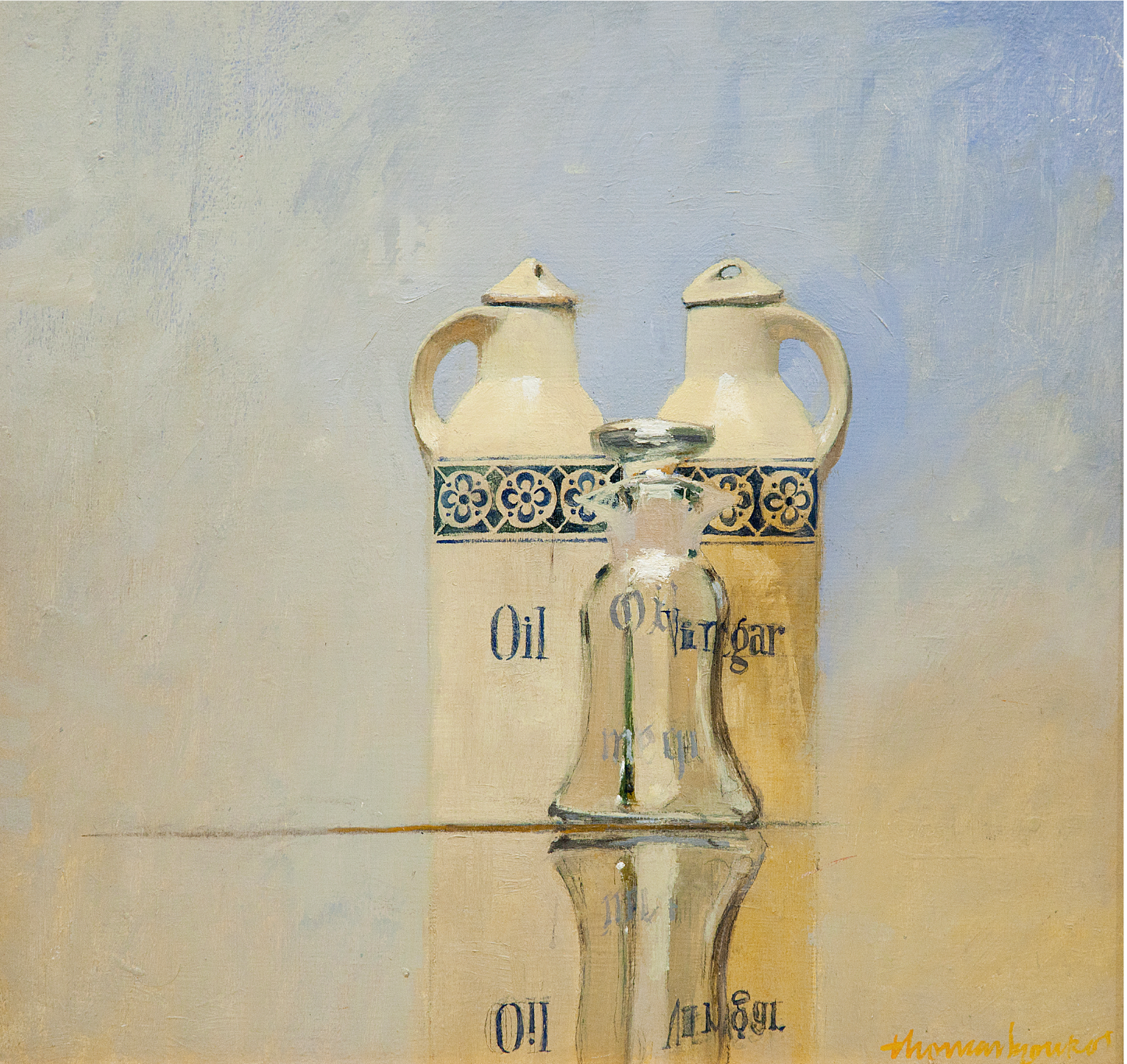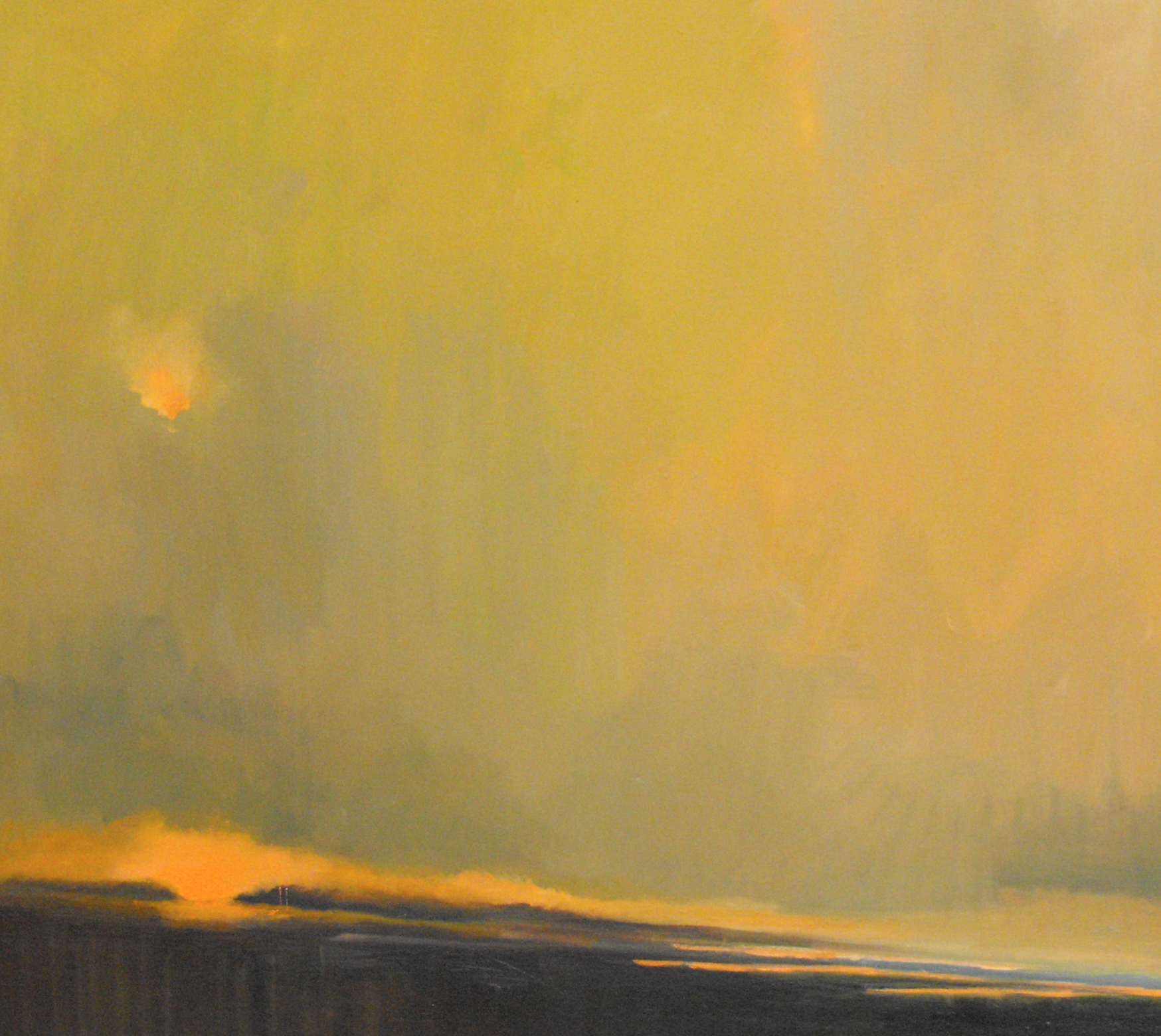On Thomas Sgouros: A Conversation with Gallerist Cade Tompkins
July 09, 2016

Cade Tompkins, of Cade Tompkins Projects (Providence, Rhode Island), who represents the Estate of Thomas Sgouros, knew the artist from 1998 until his death in 2012. On one of our visits to the ISB Gallery at RISD to see the recent Sgouros exhibit, we spoke to her about Sgouros, whom she frequently visited in his studio in the last years of his life.
A’Dora Phillips: You mentioned that after Sgouros’s vision was affected by macular degeneration, he paused before resetting his career, so to speak. It was a dark time for him, out of which came his Remembered Landscapes. Did he experiment with other modes of working before the landscapes came to him?
Cade Tompkins: As far as I know, Tom went from the studio still lifes to the landscapes immediately. However, the landscape presents itself in those studio still lifes more often than not. Still lifes sitting upon the ground, the sky being very clearly sky, even though they are still lifes. The vinegar and oil jars are a great example of that—blue sky with a glassy, watery ground reflecting the still life. He took what he knew and used it.
Phillips: What did working from memory mean for him?
Tompkins: While I’m not sure I can answer for him, I believe he had a great love of nature and a great respect for some of the major practitioners of landscape painting—James McNeil Whistler, William Merritt Chase, Asher B. Durand, Martin Johnson Heade. The Remembered Landscapes came out of that. He had a large collection of books. Whenever I went into his studio, he’d have a book on Turner or someone else open. He was always looking at landscape paintings.
Phillips: You mentioned that Sgouros “walked toward his macular degeneration.” In what sense?
Tompkins: In the scale of the big paintings. Before he got macular degeneration and started painting his Remembered Landscapes, his paintings were confined to a format of about 14 x 18 inches, or thereabout. His first Remembered Landscapes were also about this size, but then he got his bearings, or sea legs, and he let it explode into enormous paintings. That’s pretty brave.

Phillips: What attracted him about working on a large scale?
Tompkins: There were a number of things, I suspect, including a sense of freedom to be abstract. Also, larger scale means larger brush strokes. The brush strokes in the Remembered Landscapes are so big and loose and bold. Which he could see better and probably thought, “why the heck not?” You move into these paintings when you look at them. You don’t step back. You come into them, because that’s how he was seeing things and painting, moving in really close to look, and then stepping back.
Phillips: What else did you notice about the way he worked?
Tompkins: He could see color to some degree—he mentions in a 2009 video profile that he uses a jeweler’s loupe to help with that—and could see pattern close up. He had his colors lined up on his palette, pre-mixed and labeled.
A painting would sit on the easel for months. He painted slowly. He revisited paintings. He destroyed paintings that he didn’t like. And he was critical of his work. Very critical.
Brian Schumacher: It almost seems to me, when I look at his paintings, that they’re exercises in remembered painting, rather than remembered landscapes, by which I mean he was working with remembering and deploying the technical means of painting with regard to color shifts, edge conditions, foreground and background, etc.
Tompkins: He was absolutely relying on all of his skills in that regard, because that was his only guide once he had macular degeneration to make it all come together and become a work of art, as opposed to a lot of paint on the canvas.
Phillips: As an artist with low vision, how did he judge his work while he was working on it? How did he know when it was finished?
Tompkins: The existential question for every artist, even well-sighted and medium-sighted, is when is a work finished. When do I stop? He always had empty frames of many different sizes in his studio and would hold them up to canvases, and when a painting looked right to him in a frame, he would say, “I’m finished.” I don’t know how he saw when it looked right. We’ll never know that. I know that he struggled with some paintings. I saw them in process. When he did feel that a painting was done, he would label it with the date. So there’s always a Roman numeral, which is the month, and a day date, which is the day, followed by the year. So it would be like, IX.3.09.
Phillips: Do you have any thoughts about what Sgouros most wanted to achieve as an artist? What do you think it was important for him to do?
Tompkins: Keep working. He was very dedicated to his work schedule. Beyond this, I don’t know if I can speak for him, because he was not the type of man to say, “Here’s my goal.” He was of that era when they didn’t talk about things like that.
So I can only tell you what I think his legacy is. I think he leaves a double legacy. One is his long teaching career, and what he gave to all of his students. The number of people who contact me all the time, saying that they were former students of his, is impressive. And he was a pretty tough teacher. Not easy. He demanded a lot, but the people who made it through were grateful. I guess the others just shrank away. Not everyone is cut out to be an artist. It takes talent and courage.
And then, of course, he left this beautiful work for all of us to enjoy and to live with and to share. That, he was a little bit more quiet about. He wasn’t a proponent of getting his work out there. I think he’ll be one of those artists who people will keep discovering over and over and over again. His fan base will grow. That’s the nice thing about being an artist. You leave something beautiful for the world to really enjoy and to appreciate.
